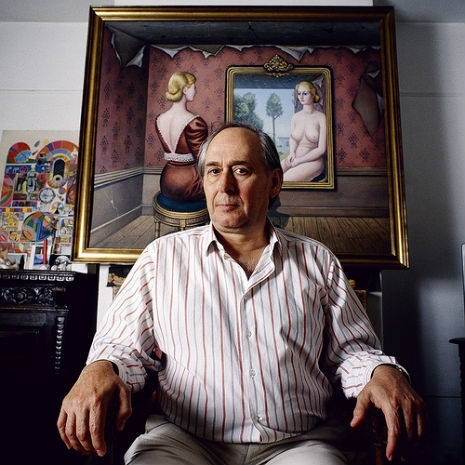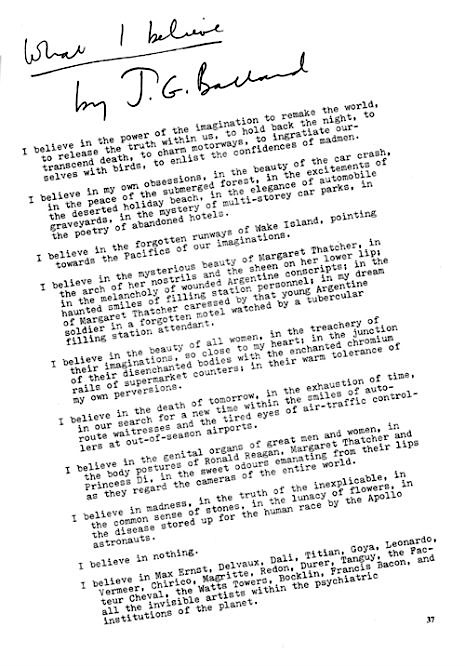
J. G. Ballard’s prose poem “What I Believe” was originally published in the French magazine Science Fiction, in January 1984. It was written in response to a request from editor Daniel Riche for the series entitled “Ce que je crois.” Described as “part poem part prayer” it offers a personal and amusing catalog of tropes and memes, the recurrent imagery, themes, and influences which are to be found in Ballard’s work.
Ballard’s poem subverts the pomposity of the traditional “What I believe” list, where you expect long meanders into politics and self-justification. Ballard’s is more fun, though as equally revealing as those written by Bertrand Russell or E. M. Forster.
The animation I believe or Credo was created for the first exhibition dedicated to J. G. Ballard and his work, which was held at the Centre de Cultura Contemporània de Barcelona (CCCB), Spain, in 2008.
It should be noted this is an edited version of Ballard’s “What I Believe,” as read by the author on the documentary series The South Bank Show, in 2006.
“I believe in the power of the imagination to remake the world, to release the truth within us, to hold back the night, to transcend death, to charm motorways, to ingratiate ourselves with birds, to enlist the confidences of madmen.
“I believe in my own obsessions, in the beauty of the car crash, in the peace of the submerged forest, in the excitements of the deserted holiday beach, in the elegance of automobile graveyards, in the mystery of multi-storey car parks, in the poetry of abandoned hotels.”
Here the poem jumps, excising Ballard’s belief “in the mysterious beauty of Margaret Thatcher, in the arch of her nostrils and the sheen of her lower lip…” too problematic for those on the Left in TV, where abhorrence is the expected response to Mrs. T. However, Ballard pointedly goes on to imagine Thatcher “caressed by that young Argentine soldier in a forgotten motel watched by a tubercular filling station attendant.”
Ballard admired Thatcher, and said in an interview contained in RE/Search that he had almost jumped for joy when the Iron Lady was first elected in 1979. But to be fair, so did most of the British voting public, hence Thatcher’s dominance in power over three elections. Margaret Thatcher was the kind of strong woman Ballard admired, though he did later satirize her as the environmentalist zealot, Dr. Barbara in Rushing to Paradise.

The first page from Ballard’s ‘What I Believe.’ See the whole manuscript here.
Like the artist Francis Bacon, Ballard reworked his own personal obsessions in his work, he mined a distinctive style of fiction that was instantly recognizable—airport car parks, empty swimming pools, deserted beaches, forgotten motels, etc etc. These are the memories of his childhood in Shanghai, as filtered through the prism of his imagination.
Ballard rated Bacon as “the greatest painter of the post-war world,” and once described himself as “disappointed painter”:
”I think in many ways I am a sort of disappointed painter, I always wanted to be a painter, but simply lacked the technical ability, lacked the talent. In fact, people say my novels are tremendously visual, in a sense I paint my novels, there you have the life work of a frustrated painter.”
But back to the poem, where Ballard continues with his belief “in the beauty of all woman, in the treachery of their imagination, so close to my heart; in the junction of their disenchanted bodies with the enchanted chromium rails of supermarket counters; in their warm tolerance of my own perversions.”
“I believe in the genital organs of great men and women, in the body postures of Ronald Reagan, Margaret Thatcher and Princes Di, in the sweet odours emanating from their lips as they regard the cameras of the entire world.
“I believe in madness, in the truth of the inexplicable, in the common sense of stones, in the lunacy of flowers, in the disease stored up for the human race by the Apollo astronauts.
“I believe in nothing.”
He continues with a list of his favorite artists (“Max Ernst, Delvaux, Dali, Titian, Goya, Leonardo…”), before returning to his personal and ficitional obsessions: “...the impossibility of existence…adolescent women, in the corruption of their own leg stances…I believe in flight…the surgeon’s knife…supermarkets…video-recorders…department store windows…the non-existance fo the past, in the death of the future, and the infinite possibilities of the present.”
This is all missed out, but we join Ballard towards the end of his second typed page:
“I believe in anxiety, psychosis and despair.
“I believe in the perversions, in the infatuations with trees, princeses, prime ministers, derelict filling stations (more beautiful than the Taj Mahal), clouds and birds.
“I believe in the death of the emotions and the triumph of the imagination.”
We skip his belief in cities like Tokyo, Benidorm, the island Eniwetok and the location, Dealey Plaza, before saying he believes in “alcoholism, venereal disease, fever and exhaustion.” We then join Ballard towards as he recites the last lines of his poem.
“I believe in all excuses.
“I believe all reasons.
“I believe all hallucinations.
“I believe all anger.
“I believe all mythologies, memories, lies, fantasies, evasions.
“I believe in the mystery and melancholy of a hand, in the kindness of trees, in the wisdom of light.”
When interviewed by the Sunday Express magazine, (August 20, 1995), on what he believed in, Ballard answered:
”The power of the imagination to remake the world.”
The essence of his poem was still paramount.
Does anyone dance in a Ballard story? Is there any music? He claimed there wasn’t, claimed he had a tin-ear and that:
“The most beautiful music in the world is the sound of machine guns.”
That maybe true, but here is the whole of Ballard’s “What I Believe” with accompanying music and dance.
H/T Suzanne Moore!